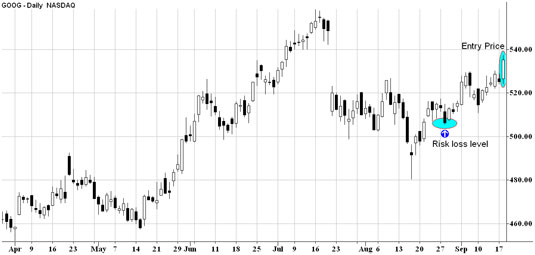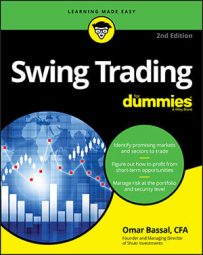The way you manage risk at the individual stock level is through position sizing. And to set your position size, you have to know how much you’re willing to lose. That loss potential is directly related to the purpose of a stop-loss order, which ensures that should you be wrong — and you will be, many times — you can exit the position with (ideally) just a small loss.
Figure out how much you’re willing to lose
Most professional swing traders limit the amount of loss they’ll tolerate from a single position to 0.25 percent to 2 percent of total capital. Remember: Your loss will be affected by commissions, slippage, and market impact (the possibility of your trade moving the stock price up or down). Therefore, it may be best to stick to a yardstick of 0.75 percent of your capital, anticipating that these other costs will likely push your total loss to 1.25 percent or so of your capital.Before you even determine how much to invest in a security, you must first determine how much you’re willing to lose. If you agree with the 0.75 percent loss threshold that I recommend, simply take out a handy dandy calculator and compute:
0.75% × Your capital = Tolerable lossIf your portfolio is $50,000, the most you should be willing to lose on a single position is $375.
The amount you risk on a single position is different from the amount you buy or sell of that security. You may risk 1 percent or $1,000 (if your account value is $100,000) on a single position but end up buying $8,000 worth of that security. To achieve the risk of 1 percent, you must exit the position if the loss on the $8,000 reaches $1,000.
Set your position size
You can position size either by applying a percent of capital approach (a constant rate of capital, say 5 percent) or by allocating new positions by a risk level you identify. Regardless of which strategy you pursue, make sure you include some discussion in your trading plan on how you determine the risk level.By percent of capital
Setting your position size based on a percent of capital is the simplest way to allocate capital to new positions. For example, if you have an account worth $50,000 and select a 3 percent level of capital to invest in each security, you allocate $1,500 to each trade.Many position traders (individuals with time horizons measured in months) invest an equal percentage of capital to each of their investments. As their capital base grows, they can invest more in each position. Conversely, as their capital base shrinks, they invest less in each position.
Ultimately, invest in ways you feel most comfortable with. However, I strongly advise against varying the percent of capital invested in new securities instead of using a constant percent of capital approach, because setting different percentages can result in random performance. Having a higher conviction in one trade (and, thus, allocating a higher percentage to it) may interfere with the success of your strategy if you’re a poor predictor of your own success. Trading doesn’t have to be complicated to be fun and profitable. Adding complexity where none is needed can lead to sub-par returns.
You won’t find a hard and fast rule when it comes to selecting a specific percentage level to use in setting position size. Choose a percentage level that’s too small (such as 0.5 percent), and hitting a home run won’t do much to boost your bottom line. But select a level that’s too large (such as 10 percent), and you could lose your shirt if the stock gaps down hard. Your stop-loss levels can only limit risk so much, and a security that gaps down will result in a loss larger than the 0.25 percent to 2 percent limit described earlier.
Use the following rules to help you set your percent of capital position sizing level if you decide to use this method.
- Set a small percent of capital level (2 percent to 4 percent) if you trade securities that exhibit
- Illiquidity (remember, what’s liquid to you may not be liquid to a $1 billion investment fund; in other words, size matters)
- Low share prices ($10 or less is low)
- High betas (anything above 2.0)
- Small capitalization size (below $300 million)
- Set a large percent of capital level (4 percent to 8 percent) if you trade securities that exhibit
- Liquidity
- High share prices
- Low betas
- Mid and large capitalization sizes
Here’s an example of this process at work: Assuming an account value of $50,000 and a loss threshold level of 0.75 percent, the maximum loss you can tolerate on any one position is $375. You determine the time is right to buy shares in Dummies Corporation at $40 per share. You also decide to use a 6 percent of capital allocation approach to your swing trading. Where do you place your stop loss?
Your stop loss should be set at a price that yields a loss of $375. Investing 6 percent of your assets in Dummies Corporation means you’ll buy 75 shares:
6 percent × $50,000 = $3,000 / $40 per share = 75 sharesTo arrive at your stop-loss level, divide your loss threshold by the number of shares you buy; then subtract the result from your purchase price to get your stop-loss level:
$375 / 75 shares = $5$40 – $5 = $35 stop-loss level
By risk level
Setting your position size using a percent of capital method may seem arbitrary. After all, isn’t that saying that you have no idea which trade will be profitable and which one won’t be?Technically, the answer to your astute question is yes; in effect, you’re saying that you have no idea which trade will be profitable. But then again, you wouldn’t be trading in the first place if you knew the trade wouldn’t be profitable.
A smarter method of setting your position size is varying it according to your desired exit level. In the example that I set up in the previous section, you compute an exit level strictly based on the price that would produce a loss of 0.75 percent of your capital. Alternatively, you can determine a key level at which you want to exit and then determine a position size based on that level. This is how most professionals swing trade. An arbitrary price may have no meaning ($35 in the previous example), whereas a specific price level may signal the end or beginning of a trend. I use a chart to illustrate how a specific level can help you determine a position size.
The following figure shows a chart of Alphabet Inc., commonly referred to as Google. Google’s shares have been consolidating and look ready to break out. Eager to make a quick buck, you decide to purchase shares. Source: TradeStation Technologies
Source: TradeStation TechnologiesAssessing a chart can help you calculate how large a position to take.
Before you calculate how large a position to take, assess the chart. This daily chart shows Google’s stock price from early April through mid-September. Google’s stock rose strongly from mid-May through late July — up 22 percent in two months. However, a poor earnings report sent Google’s stock sharply down (and serves as a reminder that trading around earnings reports can be hazardous).
Pretend today is September 18, and you’ve decided Google is worth a swing trade. How much of your capital should you invest?
Setting your position size based on a risk level requires you to determine a price that, if reached, indicates that the trade has gone sour. Obviously, if shares fall to $460, you have a hint that something isn’t right. But that’s far too late — you need a more immediate warning sign.
Try using a previous swing low as a line in the sand for your stop-loss level. In this example, assume that the recent swing low highlighted in the chart is the level that, if reached, indicates that you’re wrong about the trade. That level is $505.
Google’s stock is trading at $545, and you’re willing to risk 0.75 percent of your capital on each trade. (Remember: 0.75 percent represents the loss you’re willing to tolerate from a position, not the maximum amount you’re willing to allocate to a single position.) To calculate how many shares of Google to buy, use this formula and plug in your numbers:
Amount of capital at risk / (Entry price – Stop-loss level)Thus, setting your position size based on your risk level means purchasing 9 shares of Google. (Round down when you have a fraction. Rounding up may mean adding more risk, whereas rounding down always keeps you below your specified loss threshold.)$375 (or 0.75% of $50,000) / ($545 – $505) = 9.375 shares, or 9 shares
This example brings to light one weakness of this approach: The closer the exit price is to your entry price, the larger the implied position. In fact, if your exit price is $1 or less than your entry price, the preceding formula may tell you to invest more than your total capital in one stock, which makes no sense!
The solution to this weakness is to put a ceiling on the amount you invest in any security. Colin Nicholson, a prolific swing trader from Australia, places a 6 percent ceiling on his trades. In the example, if you purchase 9 shares of Google at $545, you’re investing 9.81 percent of your $50,000 capital in one stock.Although technically only 0.75 percent of your capital is at risk (if you place your stop loss), there’s always a chance that the stock will gap down and cause your loss to be much greater than your stop-loss order. Stop-loss orders don’t guarantee an exit at the price specified because there’s always the chance a security may gap lower.

